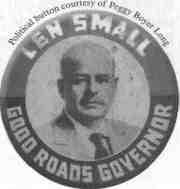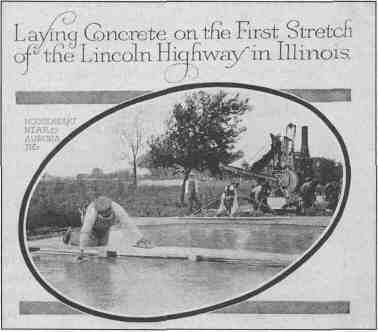

Photograph courtesy of Mike Jackson
Illinois' old country roads were intended for horses, not cars. Made of dirt, they were outright impassible a quarter of the year.
The sight of a Model T stuck in the mud was a common one throughout Illinois circa 1920, as car ownership had grown explosively the previous decade. But farmers were lifted out of the muck with the administration of the "Good Roads Governor," Len Small, who served as chief executive from 1921 to 1929. An entire statewide system of "hard roads" was designed and constructed during Small's reign, though he built on the foundation paved by predecessors Edward F. Dunne and Frank Lowden. Small had something to boast about. Illinois' extensive highway building program of the 1920s was unbeatable nationally in terms of expense, size and research findings. But it was Govs. Dunne and Lowden who laid the political base for Small to undertake this massive public works program. During their terms, the responsibility for road building was removed from the authority of local townships and placed in the hands of a state highway department. Townships couldn't shoulder the financial burden of building an intercity highway system to accommodate the growing demand of the state's car owners.
In 1910, the Illinois legislature created auto registration fees to help fund highway building. Permission for bond financing for highways came in 1913.
Then in 1917, these political efforts passed an important milestone when state voters overwhelmingly approved the issue of $60 million in bonds for a state highway system.

|

Photograph courtesy of Mike Jackson |
Small reaped the benefits of this political groundwork. During his administration, more than 7, 000 miles of paved roads were built — far more than the initial goal of 4, 000 miles established under Gov. Lowden. Small expanded the program by an additional 5, 000 miles with another $100 million in highway bonds. A motor fuel tax to pay for highways was approved in 1927, but was not implemented until the early 1930s.
With money to build highways, the state launched an investigation into the most effective construction materials. Of the first state-aid highways, built in 1915, 50 percent were concrete, 20 percent were brick, 20 percent earth and the remainder gravel or macadam,
Illinois Issues March 2000 / 27
a solid mass formed of broken stone.
In the early 1920s, the Bureau of Public Roads constructed a test highway west of Springfield known as the Bates Experimental Highway. The project was nationally significant for its conclusion that concrete was the best material for highway building. The Bates test produced a precise design for efficient concrete use. By 1925, this model was adopted by more than 33 states.
Gov. Small's advocacy for good roads met its biggest challenge in 1921, when bids came in 25 percent higher than estimates. It was no small coincidence that the price of concrete had tripled from the preceding year. If these bids had been accepted, the public wouldn't have gotten all of the promised roads. So, Gov. Small and his chief highway engineer rejected them all, warning that no bids would be awarded above the price of $30, 000 per mile for an 18-foot-wide concrete road. The strategy worked and road building began in earnest. The 1921 Illinois Annual Report stated that the average cost of a mile of 18-foot-wide highway was $28, 553.
With the financial, technical and construction issues resolved, Illinois road builders went to work. In an era of marathon dancing, flagpole sitting and other tests of personal endurance, Illinois would set records in road building for "most feet of highway in a day" and "most miles of highway in a year." Each year, new miles were added: 413 miles in 1921, 741 miles in 1922, 1, 085 miles in 1923 and 1, 230 miles in 1924. During the 1923 construction season, 11, 750 men and 183 paving mixers were in use. By the end of 1926, Illinois had completed more than 5, 434 miles of paved roads, by far more than any other state in the nation. That year also marked the adoption of the uniform federal highway numbering system that is still in use. It was the birth of such names as Route 66 and Highway 40 and U.S. Route 30 — and the end of such names as the Lincoln Highway.
Small's program resulted in hard roads throughout the state, with the noticeable exception of LaSalle County. Small's opponent in the 1924 Republican primary just happened to come from Streator, which is located in what was a very muddy LaSalle County.
Gov. Small's network of hard roads served Illinoisans until it was supplanted by the Interstate highway system of the 1950s.
Mike Jackson, who works for the Illinois Historic Preservation Agency, is a visiting professor of architecture at the University of Illinois at Urbana-Campaign.
28 / March 2000 Illinois Issues